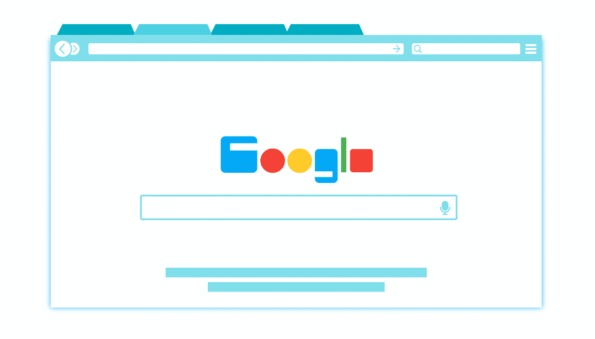If you’ve ever used the internet, then you might have heard of a website called Google. Of course, you have, who hasn’t? Since it was founded back in 1998 by Larry Page and Sergey Brin, the search engine has become easily one of the biggest sites on the internet, with over 3.5 billion searches being made on it every day. So, it’s no surprise that Google marketing tools have become such a popular alternative all over the world.
In fact, it has become so widespread, that the word Google has become a verb in its own right, often used to replace ‘search’ when people are browsing the internet. None of Google’s other competitors in the search engine business even come close, as Google dominates with a 69% market share.
Due to Google’s sheer size and presence on the internet, it has become a tool that almost no user can live without.
Its role as the go-to search engine has essentially made it into the main highway of the internet, which every user has to travel on.
With so much traffic going through Google every day, it also means the search engine has a huge amount of useful data for marketers.
This, therefore, makes it invaluable to a marketer as not only can it get them in front of millions of consumers, it also allows them to target the right people who are more likely to make a sale.
It’s crucial that every digital marketer makes use of Google.
Without it, your campaigns will struggle to even get off the ground. Remember, Google is also so much more than just a search engine. It’s an analytics tool, a mailing platform, management software, and lots more. You need to think beyond just where you end up on search results.
But with so much on offer from Alphabet’s developers, it can be hard knowing exactly where to start and what you need to boost your marketing.
Fortunately, there are plenty of marketing tools available for use with Google. Using these tools can help give your business an edge in an already very competitive digital marketing field. To help guide you, we’ve put together this handy list of our favorite Google marketing tools to give your campaigns the boost it needs.
- More Helpful Reading: https://www.fannit.com/blog/google-ranking-check/

What Are the Best Google Marketing Tools?
As we mentioned earlier, Google has grown from being just a search engine to so much more.
This is great news for you as a business owner as it means there’s so much more that you can do with it to reach customers and generate leads.
Here are some of the best Google marketing tools out there to help you navigate your Google marketing strategy and help your business grow.
1. Google Ads (Formerly Google AdWords)
One of the most popular and well-known Google marketing tools is Google AdWords, now known as simply Ads.
Google AdWords is Google’s pay-per-click (PPC) advertising offer. The way that PPC works is that it allows you to bid on certain keywords.
For example, if you sell bicycles, you could bid on the keyword ‘bike stores near me.’
That way when somebody searches that keyword, your site’s link will appear at the top of the search results page.
One of the great things about PPC however, is that you only pay if it actually drives traffic to your business website.
If a user ignores the link, even though it is at the top of the page, you won’t have to pay anything. It’s only when they actually click on it that it will cost money.
The clue is in the name.
Google AdWords also offers additional targeting beyond just keywords, such as location, if they’re using a mobile or desktop browser, and more, to make sure you’re reaching the right consumers.
- More Helpful Reading: https://www.fannit.com/blog/google-ads-pricing/
2. Google Keyword Planner
If you’ve decided to make use of Google Ads, but are having difficulty deciding on the best keywords to use for your campaign, Google does offer some help.
The Google Keyword Planner is designed to assist you when finding keywords, by offering keyword ideas, and is available if you already have an Ads account.
Keyword Planner works like this.
You tell the tool what area you want to own, and it offers groups of keywords that are related to it, and lets you get deeper into the term. For example, if you could type in Public Relations, and the tool would offer keyword ideas such as ‘PR agencies’, ‘best PR strategies’, ‘why do I need PR’, and so on.
It will also tell you how much a keyword is trending, i.e. which keyword is currently the most popular.
Keyword Planner will also tell you the approximate cost of each one if you are to include it in your PPC campaign.
3. Google My Business
If you’re keen to get your business on Google’s search results, and you definitely should be but do not have the budget required to run a PPC advertising campaign, there are still options available.
Google My Business is a free Google advertising service that any business can sign up for.
All you have to do is claim your Google My Business spot and your business will be included on any relevant search queries for local search results.
Google My Business is therefore a simple way to make sure you get noticed. You don’t even need an account to do it.
So for example, if you are a hairdresser located in Seattle, you can claim your listing, so the next time somebody does a Google search for ‘hairdressers in Seattle’, your business will be listed along with its address thanks to Google My Business. It will show up on Maps as well, pinpointing your address to potential customers.
4. Google Trends
Google Trends is an excellent free Google marketing tool that helps to let you know which topics and phrases are trending in real-time.
Trends can provide quite in-depth analytics as well, by showing how certain keywords have trended over a set period of time, how their popularity fluctuates by location and lets you compare them against each other.
This makes it really helpful when you’re trying to decide what word to use for a blog title for example.
Just pop in all the options into Google Trends and see which one is the most popular.
Being able to see how a keyword’s popularity can be really helpful.
For example, if you notice one always spikes in July you can start planning your content for that month early. One advantage of Google Trends is that it’s completely free and available to anyone. You don’t need to set up an Ads account to use Google Trends either.
Trends’ intuitive design makes it really simple and easy to use and is one of the best free tools out there.
You can easily end up spending hours playing around with the different keywords and search parameters, so get stuck in!
5. Google Analytics
In the data-driven world of digital marketing, it’s vital that you stay on top of all statistics related to your campaigns.
Without it, you won’t be able to measure ROI, see what’s performing well, and how to report results back to your clients.
This is another area where Google is a marketer’s best friend. Google Analytics is an incredibly powerful analysis tool and is also completely free to use, so you don’t need an account.
You can use it to help your marketing campaigns by providing invaluable insight.
By using it with your website, it can show you an in-depth look into your website traffic.
You can use it to see at what times are you generating the most traffic, and most usefully, which pages are the most visited.
This helps to show which pages are working well, and which need some tweaking. If a page isn’t visited often, there’s a good chance its SEO needs improvement as users are probably not able to find it on search engines.
It can go beyond this as well and inform you of who and where your traffic is coming from.
Google Analytics provides statistics on the demographics of your visitors such as location and language they’re viewing your website on.
Google Analytics can also tell you how visitors found your website.
You can see who is coming from social media platforms such as Facebook or Instagram, who was directed from a third-party site, and how many are coming from search engines.
You can also use it to calculate the percentage of visitors who complete a conversion.
This is especially useful if you have an eCommerce platform on your website or are trying to get people to sign up for a mailing list.
- More Helpful Reading: https://www.fannit.com/blog/seo-google-analytics-tips/
6. Google Search Console
Google Analytics isn’t the only useful analytics tool on offer from Google.
Search Console is also a fantastic service that can help any digital marketer. It essentially uses data from your website to help show you how your website is seen by Google’s search algorithm, which is invaluable insight for any business trying to improve its SEO.
You can use it to check your site’s health. This means it will scan your website and look for any red flags or errors that could be harming your SEO and that need fixing.
This could include things such as malware, blocked and broken URLs, crawling errors, and more.
Once Search Console has highlighted these, you can go in and get them fixed, which should help your SEO.
It can also show you what search terms and queries your website is showing up on, and what their ranking is.
This can help you know which terms you need to work harder at in order to get a better ranking.
More importantly, if there is a keyword you’re keen for your website to appear on but aren’t, Search Console can alert you to this fact and let you know you need to work on your SEO.
In fact, Search Console can offer suggestions for improving your SEO, such as tweaking your sitemap, HTML, keywords, and other factors.
- Free Resource! Access Our Free SEO Website Checker & Grader
7. Google Suite
Most computer users probably grew up using Microsoft Office when working with their computer.
Programs such as Microsoft Word, Excel, and PowerPoint were the go-to software for the average office worker. However, these can be expensive and require regular updating to stay ahead of the game.
Google Suite is Alphabet’s answer to Microsoft Office but in a more accessible and flexible way.
It’s all online and can be accessed by anyone for free. There are a number of great tools within Suite so let’s go through them.
Google Docs
Content marketing is an incredibly important part of any digital campaign. Well-written content can engage your target audience in ways that traditional advertising can’t.
It also helps to provide something that the audience wants, such as information, interest, and more, meaning that consumers will be more willing to consume it.
Of course to be able to write engaging, thoughtful content, you need somewhere to write it first. Google Docs is Google’s answer to this.
In fact, this blog post that you’re currently reading was initially written on Google Docs.
It’s incredibly similar to Microsoft Word, however is entirely hosted online, and is also free to use. It also has advantages that Word lacks.
For example, Docs is an excellent way of collaborating with your wider team. If a document you’re working on needs to be seen by your whole team, you can easily share it with multiple people, who can view, comment or edit simultaneously.
This makes it great for team working, as well as for remote working which has risen dramatically in the last year.
It’s not just for writing copy either, you can also create forms and surveys to send out to your mailing list to help gather insights and data amongst your customers.
Google Sheets
For a good marketing campaign to succeed, it needs to be organized.
Ask any marketer, they’ll tell you they spend a significant portion of their time staying on top of their posting schedule, keeping track of what’s due to be published and what needs booking. In this aspect of the job, a spreadsheet is a marketer’s best friend.
Google Sheets is a spreadsheet tool that every marketer should be using.
Like Google Docs, a spreadsheet can be shared across a team so everyone can collaborate on it in real-time, making updates to schedules when needed.
Another important factor for a marketer that Sheets can help with that we’ve already discussed is data.
Spreadsheets are a great place to store your data from surveys and other research. Sheets has similar features to Microsoft Excel in that you can use it to analyze the data and crunch the numbers on the spreadsheet itself, yet it is also completely free.
Google Slides
As every marketer knows, presentation is everything. Well, perhaps not everything, but controlling how you’re seen is a vitally important factor in our line of work.
Whether you’re looking for new business or reporting to a current client on the results you’ve got, it helps to have a professional-looking presentation.
Google Slides is Google’s version of Microsoft PowerPoint. It works in much the same way, allowing you to create presentations for a variety of different purposes.
Also, like the rest of Google Suite, it allows for collaborative work, by letting multiple different people work on the same document at the same time.
8. Google Mail (Gmail)
In today’s digital age, email is one of the most important forms of communication.
This goes for almost every different kind of business in every industry, and beyond that, as people use it outside the world of work for socializing and more.
Google Mail, or GMail as it was rebranded, is one of the most popular email platforms out there, and for good reason.
Gmail has a very intuitive and easy-to-use user interface (UI), meaning anyone can use it, regardless of how tech-literate they are.
It also comes with up to 15GB of free data storage, which always comes in handy.
It’s excellent for small businesses too.
As marketers, communication is our job, which means that we get a lot of it! With all the emails that we constantly send and receive, it can be hard to keep track.
Gmail has really handy labeling features, meaning emails can be sorted by topic or sender.
This makes it much easier to stay on track of conversations and makes them easier to find when needed.
It also links up nicely with your Google Drive, making it even easier to share documents with contacts via email.
It’s also possible to do a mail merge from your Google Docs through Gmail, making it an excellent option for email marketing.
Email marketing is one of the most useful tools for any marketer, as it only targets those who have voluntarily shared their contact information with your company.
This shows a significant level of interest, meaning they are more likely to complete a conversion and make a sale when you target them with promotional material.
9. Google Alerts
Every marketer needs to make sure that they stay ahead of the game, and always know what is happening in the ever-evolving media landscape.
However, which so much information out there it can be hard to sift through to find the stories that are related to your campaigns.
Fortunately, this is where Google Alerts can help.
Google Alerts is another free tool from Google. It’s a piece of software that constantly monitors the web. You can use it by selecting keywords that you would like to keep tabs on.
This could be the name of their company or client, so they always know what people are saying about them.
- More Helpful Reading: https://www.fannit.com/seo/reputation-management/
It can also help to keep an eye out on your competitors to help you always stay one step ahead, and react to what they do when needs be.
If there are certain topics that you would like your company or client to comment on, then you can use Google Alerts to track these as well.
This way you’ll always know what’s happening in the world and can use it to your advantage.
10. Google News
As we’ve just discussed, staying ahead of the news at all times is vital for a marketer.
It can help create opportunities to comment on, get the edge over your competitors or even predict potential PR crises that need dealing with promptly.
As such, any tool that can filter through all the news articles on the web and only get the relevant ones to you cannot be overestimated.
Google News is one such tool.
A strategy that many a marketer and PR use is called ‘newsjacking.’ It essentially means spotting a story that has already gathered traction in the media that is relevant to your business or clients’ business and commenting on it yourself in order to gain coverage during the peak of that topic’s popularity.
Google News is incredibly useful for this, as it aggregates relevant news stories and sorts them into an easy-to-use, intuitive dashboard.
You can list different topics that you’re interested in, as well as more specific terms such as certain companies or people, and the software will neatly sort them for you. You can also use it to search news stories by topic to see what’s happening in the industry.
- More Helpful Reading: https://www.fannit.com/seo/google-index/
11. Google Calendar
We’ve mentioned it before in this blog post, but we’ll say it again given how important it is: organization is absolutely crucial for any successful campaign
. If you lose track of when you should execute different phases of your strategy then it will probably fall flat.
A simple calendar tool can therefore go a long way to ensure success.
Google Calendar is a free-to-use tool that does exactly that, as well as having other useful features.
Like most Google products, a lot has been invested into its design, making it simple, easy to use, and very intuitive. You can easily add new items to your Google Calendar, whether you’re on your desktop or mobile, as it is all linked to your Google account.
You can use it to set reminders for the more pressing items, making sure you don’t forget them.
It’s also easy to share across your whole team, so everybody knows what everyone else is up to, making scheduling clashes far less likely.
It’s perfect for arranging meetings too, as you can create a meeting, add all the relevant information, and send out the invites, all on the same platform. Then all people need to do is simply click ‘accept’ and the meeting will be added to their calendar as well.
12. YouTube
Google bought YouTube way back in 2006 which means that it too, is technically a Google marketing tool! It’s also definitely one that a marketer should not forget about either.
YouTube has a huge reach, and enjoys over 122 million visitors a day, watching over a billion hours of video every day as well.
With these numbers, it’s important that you make use of it and view it as a marketing platform.
- More Helpful Reading: https://www.fannit.com/blog/video-marketing-for-small-business/
Video is one of the most popular mediums online today and is important for a marketer for a number of reasons. Let’s take a look at some of the stats surrounding video:
- 78% of people watch videos every week, and 54% say that they’d like to see even more video content.
- Another 54% of customers have said that they would like to see more videos from brands and businesses that they support. It’s important to give the people what they want!
- Not only is video popular amongst consumers, but it actually does a better job of getting your messages across. For example, 84% of people say that they have been convinced to buy a product or service because of a video they watched.
- The average viewer also retains 95% of the information from a video, compared to just 10% when reading text.
- Statistically, marketers who use video grow revenue 49% faster than those who don’t as well.
These stats should be enough to convince you that video is vital for every marketer, so why not make use of the largest video hosting site on the internet? You should be using YouTube almost as much as you use social platforms such as Facebook and Instagram.
13. Google AdSense
Google AdSense is another advertising tool from Google that works well with your YouTube channel (which as we’ve just discussed you should be using!), as well as your own website.
It works by placing some code in the header and sidebar of your website, which allows it to be connected with advertisers across the web.
This means that different advertisers can then bid for the advertising space on your YouTube video or website, and then pay you through AdSense for the privilege.
While it may not help to get your message out specifically, there is no harm in making some income from different online properties you own.
Often a marketer will create a niche website for a particular campaign, separate from their own website.
When the campaign is inactive, the page won’t be doing much else, so why not get a little extra revenue from it?
- More Helpful Reading: https://www.fannit.com/blog/marketing-tools/
14. Google Drive
If you’ve been using the range of tools on Google Suite, then you’ll also need somewhere to store all of your documents that your whole team can access. That said, it’s also important that not just anyone can view or edit them either. If this is the case, then you need to be using Google Drive.
Google Drive is an excellent online storage platform that your whole team can use. If you need to send multiple files to a teammate, it can be a headache, especially if the files are large. But if you save them onto Drive they can simply view them from there.
You can get up to 15GB of free storage when you first sign up, which should be plenty for most small businesses.
However, if you need to up your storage capacity, there are paid-for versions, which can scale up the amount of data you can store on the Drive, depending on how much you pay.
15. Search Ads 360
You may have been familiar with Google’s DoubleClick Search, which has now been rebranded as Search Ads 360.
For a marketer running a lot of different ads across multiple platforms over the internet, Search Ads 360 will be a time-saving lifesaver.
It’s an ad serving dashboard that lets you distribute, manage and monitor your ads that appear on other sites.
It also offers you insight into the websites your ads are on. For example, it can provide demographic information on its average visitors, such as age, location, other sites visited, interests, and keywords searched.
This can help inform if this website is the right place to be hosting ads on.
For example, if you’re advertising skateboards, you probably don’t want to host ads on a page where the average visitor age is 74!
It also lets you know if your ads are performing as well.
It can measure metrics such as your conversion rate, the number of clicks each ad receives, traffic driven, and the revenue generated by your advertising on third-party sites.
If an ad isn’t performing then it might be time to tweak it or host it on a different site.
16. Google Scholar
Google Scholar is a large online collection of academic articles, papers, and studies.
It’s the go-to place online for academic literature and is probably well familiar with many university students. But why would this be important for a marketer? Multiple reasons!
For starters, it’s an excellent resource for content marketers.
It’s often important to back up what you’ve said in a piece of content with a reliable source, showing to your consumers that you are both reputable and knowledgeable about the wider topic.
Another reason is something we’ve discussed before: data.
Data is so important for providing insight to our campaigns and can be the edge that you need to become successful.
Google Scholar has plenty of academic studies, rich with data, on almost any topic.
So why not make use of it, and make sure your marketing choices are as informed as possible?
17. Mobile-Friendly Test
Having a fast website is great, and should be something every marketer aims for. But if it’s only fast on a desktop computer, then it’s not going to be that useful.
With the advent of smartphones, more and more people are browsing the web on their phones. You need to make sure that your website is ready for it.
Mobile operating systems load pages differently from desktops, as they’re going to be viewed on a much smaller screen.
If your pages are fast on desktop but slow on mobile you’re going to miss out on a lot of potential customers.
This is where Mobile-Friendly Test comes in handy.
Mobile-Friendly Test is an additional tool offered by Google that checks to see how mobile-friendly your site is (starting to see a pattern with these names yet?).
Once it’s analyzed your website, it will let you know how suitable for mobiles it is.
If it isn’t, then the Test will offer some suggestions on how you can improve this.
It could highlight issues down to page speed, or more likely layout. Layout is crucial for mobile sites, due to the small screens they are viewed on.
If the text is too small, then visitors will struggle to read it or get frustrated having to zoom in all the time.
Other issues could be links that are too small, or too close together, making it much harder for users to tap on them with their thumbs.
18. Data Studio
As you may have noticed from reading this blog, we can’t get enough data.
So much so we keep mentioning it in this article! This is because it was one of the most valuable tools to a marketer. There’s a reason it’s often referred to as the ‘new oil’.
Data Studio is another marketing solution from Google that can make understanding data that much easier.
It provides plenty of options for turning your data into graphs and charts.
This is great because by visualizing data, you can make it much more accessible and easier to understand for those of us who don’t have a background as a statistician.
Once you’ve set it up, you can connect all of your data to your Data Studio dashboard.
Then Data Studio does the hard work for you and allows you to create useful, easy-to-understand, and informative reports.
It makes it much easier to explain to colleagues how a campaign is working, and more importantly, to show clients the metrics of your success.
19. Speed Insights
A well-working website is crucial for any business. If your site is slow and clunky to use, many visitors might simply give up and leave before they can make a sale.
It’s also highly likely that they’ll return due to poor user experience, so you may have lost that customer forever.
Not only do users not like slow websites, but neither do search engines.
If a search engine’s web crawler (the software they use to scan the web) deems your site as being too slow and hard to navigate, it won’t view it favorably.
This means that when it works out rankings, your site will be near the bottom.
If your website ends up lingering on the 4th page of the Google search results, then nobody is going to find it.
So how do you know if your page is slow, and how can you fix it if it is? Speed Insights is a solution offered by Google that gives you insight into your page speed (again, the clue is in the name).
It analyzes your pages and works out how fast it is and offers recommendations on how to fix it if it is slow.
It can tell you how to restructure your HTML to make sure it is as fast and efficient as possible, let you know if there are issues in how long it takes to talk to the server, and also how to resize images and other media content, so they’re not quite so big, making the page faster to load.
- More Helpful Reading: https://www.fannit.com/blog/pagespeed-insights/
20. Google Blogger
Google Blogger is another great platform for content marketers.
We’ve already discussed just how important content marketing is. It provides excellent engagement and allows you to connect with consumers on another level.
By providing useful or interesting information through content, they’re more likely to come back for more.
A blog is an excellent form of content marketing.
We clearly think so, as you’re reading our blog now! It lets you show off your expertise and can be regularly updated to keep your content fresh so visitors will check back to read more.
Google Blogger is perfect for writing and posting your blog.
It’s highly customizable, allowing you to adapt it to fit your particular style and feel. Once you’ve got the style down, you can keep your blog updated, providing evergreen content for your target audience.
21. Google Voice

Google Voice allows you to create a new phone number that you can use for business purposes.
But why make a new phone number with Voice rather than just using your current one?
The reason is because Voice allows you to track the number of calls on your Voice account.
Therefore you can use it to check that your number on your business sites is visible enough that potential customers can find it.
If calls are down, then it might be time to try and promote your number a bit more.
Ready to Learn More About Google Marketing Tools? Contact Fannit Today!
If you’re looking to pursue a digital marketing campaign, Google really is going to be a huge part of that, so you need to know how to use it effectively.
As we’ve discussed, there are a ton of excellent marketing tools out there that can help you achieve a variety of goals on a range of different budgets.
From Google My Business to Analytics, to Speed Insights, you need to know which tools you need to use.
If you’re eager to get started with your Google marketing campaign but are hesitant on where to start, or are spoiled for choice, why not get in touch with our marketing team today? Our team of experts can let you know which tools will be best for your brand and how to create a successful marketing campaign.
So don’t hesitate and give us a call now!
- More Helpful Reading: https://supermetrics.com/blog/google-marketing-platform





